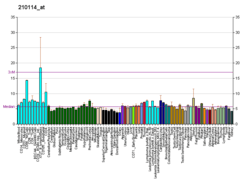Inversin is a protein that in humans is encoded by the INVS gene.[5][6]
This gene encodes a protein containing multiple ankyrin domains and two IQ calmodulin-binding domains. The encoded protein may function in renal tubular development and function, and in left-right axis determination. This protein interacts with nephrocystin and infers a connection between primary cilia function and left-right axis determination. A similar protein in mice interacts with calmodulin. Mutations in this gene have been associated with nephronophthisis type 2. Two transcript variants encoding distinct isoforms have been identified for this gene.[6]
References
- 1 2 3 GRCh38: Ensembl release 89: ENSG00000119509 - Ensembl, May 2017
- 1 2 3 GRCm38: Ensembl release 89: ENSMUSG00000028344 - Ensembl, May 2017
- ↑ "Human PubMed Reference:".
- ↑ "Mouse PubMed Reference:".
- 1 2 Otto EA, Schermer B, Obara T, O'Toole JF, Hiller KS, Mueller AM, Ruf RG, Hoefele J, Beekmann F, Landau D, Foreman JW, Goodship JA, Strachan T, Kispert A, Wolf MT, Gagnadoux MF, Nivet H, Antignac C, Walz G, Drummond IA, Benzing T, Hildebrandt F (Aug 2003). "Mutations in INVS encoding inversin cause nephronophthisis type 2, linking renal cystic disease to the function of primary cilia and left-right axis determination". Nat Genet. 34 (4): 413–20. doi:10.1038/ng1217. PMC 3732175. PMID 12872123.
- 1 2 "Entrez Gene: INVS inversin".
Further reading
- Yokoyama T, Copeland NG, Jenkins NA, et al. (1993). "Reversal of left-right asymmetry: a situs inversus mutation". Science. 260 (5108): 679–82. doi:10.1126/science.8480178. PMID 8480178.
- Haider NB, Carmi R, Shalev H, et al. (1998). "A Bedouin kindred with infantile nephronophthisis demonstrates linkage to chromosome 9 by homozygosity mapping". Am. J. Hum. Genet. 63 (5): 1404–10. doi:10.1086/302108. PMC 1377550. PMID 9792867.
- Schön P, Tsuchiya K, Lenoir D, et al. (2002). "Identification, genomic organization, chromosomal mapping and mutation analysis of the human INV gene, the ortholog of a murine gene implicated in left-right axis development and biliary atresia". Hum. Genet. 110 (2): 157–65. doi:10.1007/s00439-001-0655-5. PMID 11935322.
- Morgan D, Goodship J, Essner JJ, et al. (2002). "The left-right determinant inversin has highly conserved ankyrin repeat and IQ domains and interacts with calmodulin". Hum. Genet. 110 (4): 377–84. doi:10.1007/s00439-002-0696-4. PMID 11941489.
- Nürnberger J, Bacallao RL, Phillips CL (2003). "Inversin Forms a Complex with Catenins and N-Cadherin in Polarized Epithelial Cells". Mol. Biol. Cell. 13 (9): 3096–106. doi:10.1091/mbc.E02-04-0195. PMC 124145. PMID 12221118.
- Strausberg RL, Feingold EA, Grouse LH, et al. (2003). "Generation and initial analysis of more than 15,000 full-length human and mouse cDNA sequences". Proc. Natl. Acad. Sci. U.S.A. 99 (26): 16899–903. doi:10.1073/pnas.242603899. PMC 139241. PMID 12477932.
- Humphray SJ, Oliver K, Hunt AR, et al. (2004). "DNA sequence and analysis of human chromosome 9". Nature. 429 (6990): 369–74. doi:10.1038/nature02465. PMC 2734081. PMID 15164053.
- Gerhard DS, Wagner L, Feingold EA, et al. (2004). "The Status, Quality, and Expansion of the NIH Full-Length cDNA Project: The Mammalian Gene Collection (MGC)". Genome Res. 14 (10B): 2121–7. doi:10.1101/gr.2596504. PMC 528928. PMID 15489334.
- Otto EA, Loeys B, Khanna H, et al. (2005). "Nephrocystin-5, a ciliary IQ domain protein, is mutated in Senior-Loken syndrome and interacts with RPGR and calmodulin". Nat. Genet. 37 (3): 282–8. doi:10.1038/ng1520. PMID 15723066.
- Simons M, Gloy J, Ganner A, et al. (2005). "Inversin, the gene product mutated in nephronophthisis type II, functions as a molecular switch between Wnt signaling pathways". Nat. Genet. 37 (5): 537–43. doi:10.1038/ng1552. PMC 3733333. PMID 15852005.
- Rual JF, Venkatesan K, Hao T, et al. (2005). "Towards a proteome-scale map of the human protein-protein interaction network". Nature. 437 (7062): 1173–8. doi:10.1038/nature04209. PMID 16189514.
- O'Toole JF, Otto EA, Frishberg Y, Hildebrandt F (2007). "Retinitis pigmentosa and renal failure in a patient with mutations in INVS". Nephrol. Dial. Transplant. 21 (7): 1989–91. doi:10.1093/ndt/gfl088. PMID 16522655.
- Gilling M, Dullinger JS, Gesk S, et al. (2006). "Breakpoint Cloning and Haplotype Analysis Indicate a Single Origin of the Common Inv(10)(p11.2q21.2) Mutation among Northern Europeans". Am. J. Hum. Genet. 78 (5): 878–83. doi:10.1086/503632. PMC 1474032. PMID 16642442.
- Assadi F (2007). "Lack of NPHP2 mutations in a newborn infant with Joubert syndrome-related disorder presenting as end-stage renal disease". Pediatr. Nephrol. 22 (5): 750–2. doi:10.1007/s00467-006-0412-z. PMID 17216245.




